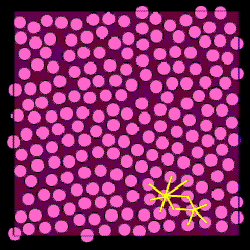Halfway Home for Thin Films

Something lurks between solid and liquid in thin films. Instead of melting smoothly from crystalline solid to fluid, thin layers of simple molecules exhibit an intermediate ordered phase with hybrid solid-liquid properties. The 12 August print issue of PRL contains simulations and experimental data providing the best evidence yet that spherical molecules pass through this “hexatic” phase.
According to theory, the hexatic phase results when molecules in a single-layer film pack close together like racked billiard balls but are not held rigidly by molecular bonds. The particles shift about like those of a liquid, but a freeze frame would reveal that the system has long-range order like a solid. Each molecule has on average six neighbors, generating a six-fold hexagonal symmetry. The occasional five-neighbored molecule is always adjacent to a molecule with seven close contacts.
The hexatic state was anticipated in the 1970s and first observed in thin layers of liquid crystalline materials in the late 1980s. But liquid crystals are made of cigar-shaped molecules that can line up into a preferred orientation. When researchers sought out the hexatic phase in molecules with more spherical proportions, conflicting simulations mired the pursuit in controversy, says Ravi Radhakrishnan of the Massachusetts Institute of Technology in Cambridge. It’s hard to detect the hexatic phase in small simulations because the six-fold symmetry fades with distance in a complicated way, he says.
So Radhakrishnan and his colleagues enlisted a posse of IBM SP2 supercomputers to crunch numbers for 64,000 spherical carbon tetrachloride (CCl4) molecules confined to a one- to two-molecule-thin film in the flat, saclike pores of carbon fibers. After letting the simulated system heat up and then come to equilibrium, they measured its degree of order and found that it matched the theoretical predictions for a hexatic.
“We were really curious as to whether this can really exist” in the lab, Radhakrishnan recalls, so the team next turned to the real world version of their simulation. By warming films of CCl4 or the chemical aniline trapped in carbon fibers and applying a strong electric field, they observed changes in the molecules’ electrical properties corresponding to phase transitions. Again they saw the theoretically predicted signature for a hexatic phase. The result is surprising, Radhakrishnan explains, “because these are extremely simple spherical molecules which have very simple molecular structure.” The hexatic state remained over a range of 60 degrees Kelvin–ten times larger than for the liquid crystal experiments–so it’s stable enough to look for industrial applications, he adds.
Joel Brock of Cornell University in Ithaca, New York, is impressed with the work because “there’s such good agreement between experiment and simulation.” Others have looked for hexatic phases in shaken ball bearings or polystyrene beads, he adds, where the existence of true thermodynamics phases isn’t clear cut. John Ho of the State University of New York at Buffalo would prefer to see more direct evidence of the hexatic behavior instead of phase transitions. But the result is surprising if correct, he says, because pores might have disrupted the hexatic ordering. “It is certainly not a given that the hexatic phase would exist in such a system.”
–JR Minkel
JR Minkel is a freelance science writer in New York City.


